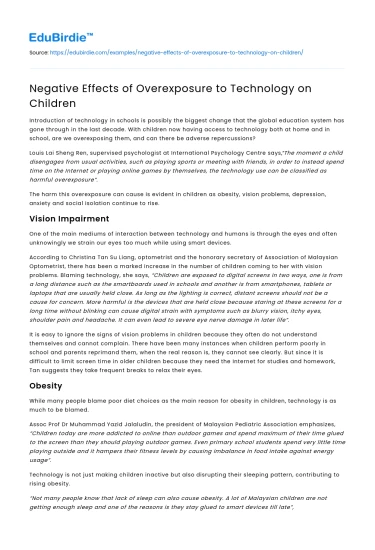Introduction of technology in schools is possibly the biggest change that the global education system has gone through in the last decade. With children now having access to technology both at home and in school, are we overexposing them, and can there be adverse repercussions?
Louis Lai Sheng Ren, supervised psychologist at International Psychology Centre says, “The moment a child disengages from usual activities, such as playing sports or meeting with friends, in order to instead spend time on the Internet or playing online games by themselves, the technology use can be classified as harmful overexposure”.
Save your time!
We can take care of your essay
- Proper editing and formatting
- Free revision, title page, and bibliography
- Flexible prices and money-back guarantee
The harm this overexposure can cause is evident in children as obesity, vision problems, depression, anxiety and social isolation continue to rise.
Vision Impairment
One of the main mediums of interaction between technology and humans is through the eyes and often unknowingly we strain our eyes too much while using smart devices.
According to Christina Tan Su Liang, optometrist and the honorary secretary of Association of Malaysian Optometrist, there has been a marked increase in the number of children coming to her with vision problems. Blaming technology, she says, “Children are exposed to digital screens in two ways, one is from a long distance such as the smartboards used in schools and another is from smartphones, tablets or laptops that are usually held close. As long as the lighting is correct, distant screens should not be a cause for concern. More harmful is the devices that are held close because staring at these screens for a long time without blinking can cause digital strain with symptoms such as blurry vision, itchy eyes, shoulder pain and headache. It can even lead to severe eye nerve damage in later life”.
It is easy to ignore the signs of vision problems in children because they often do not understand themselves and cannot complain. There have been many instances when children perform poorly in school and parents reprimand them, when the real reason is, they cannot see clearly. But since it is difficult to limit screen time in older children because they need the Internet for studies and homework, Tan suggests they take frequent breaks to relax their eyes.
Obesity
While many people blame poor diet choices as the main reason for obesity in children, technology is as much to be blamed.
Assoc Prof Dr Muhammad Yazid Jalaludin, the president of Malaysian Pediatric Association emphasizes, “Children today are more addicted to online than outdoor games and spend maximum of their time glued to the screen than they should playing outdoor games. Even primary school students spend very little time playing outside and it hampers their fitness levels by causing imbalance in food intake against energy usage”.
Technology is not just making children inactive but also disrupting their sleeping pattern, contributing to rising obesity.
“Not many people know that lack of sleep can also cause obesity. A lot of Malaysian children are not getting enough sleep and one of the reasons is they stay glued to smart devices till late”, - Dr Yazid concludes. Smart devices emit blue light and it can disrupt sleeping patterns by significantly suppressing release of melatonin (a chemical that induces sleep).
Psychological Problems
Dr Rajini Saravananthan, consultant developmental pediatrician and committee member at Malaysian Pediatric Association opines that technology in schools is not as great a problem as it is at home, since schools regulate the exposure but at home screen times often go unsupervised. Parents consciously or unconsciously hand their children smart devices, but Dr Rajini warns, “Technology should not be used as babysitters because such children grow up socially isolated, lost in their virtual world”.
This unsupervised overexposure to technology can spell even greater danger in older children, who are exposed to cyberbullying, child pornography and violence, especially through social media. On one hand, social media can contribute to social and psychological well-being by extending social networks, but when chosen over in-person interactions, it can affect children’s mental health by isolating them from their peers.
Solutions
The solution is supervision. Adults need to keep a tab on the amount as well as the kind of technology the children are being exposed to, and schools need to do the same. Schools, especially private and international schools are already doing their part by ensuring that children stay active as much as possible by offering varied sports facilities and encouraging students to actively participate, providing only healthy food options in canteens and deliberately holding classes in different buildings to make children move. Many international schools also ban use of smart devices in between classes to allow children time away from technology, have firewalls to prevent students from visiting potentially problematic websites and teach about good cyber citizenship.
But schools can only do so much. The rest is up to parents to ensure that children continue being active and use technology sparingly and under the strict supervision at home.






 Stuck on your essay?
Stuck on your essay?

